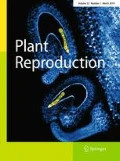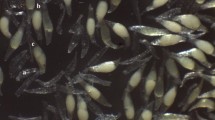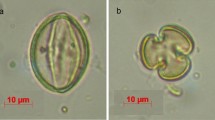Abstract
Titanotrichum oldhamii produces both flowers and asexual bulbils on its inflorescences. However, field observations and herbarium collections indicate that seed set is infrequent and that most reproduction is from vegetative bulbils. We have investigated the failure of sexual reproduction and identified four major causes: (1) in the wild, the seed:ovule ratio for open pollination was only 1.9%, in contrast to 10.1% for artificial cross-pollination, implying poor pollinator services. (2) The overall reproductive success was 5–10 times greater in glasshouse pollination treatments compared to field treatments. This suggests suboptimal environmental conditions for seed set in natural habitats, which may eliminate natural seed set completely. (3) Pollination experiments showed that outcrossed populations set significantly more seed and had higher germination rates than intra-populational and self crosses, in both field and glasshouse experiments. T. oldhamii thus appears to benefit from wide outcrossing. Pollen transfer between populations, however, seems to be infrequent because of the rarity and scattered distribution of Titanotrichum populations. (4) Flowers near the apex of the inflorescence are less likely to set seed, especially late in the season when inflorescences convert to bulbil production. In these late flowers, pollen tubes showed poor guidance as they approach the micropyle of the ovules. Even under optimal glasshouse conditions, the average outcrossing success was only 0.229. Almost one-half of the ovules remained undeveloped and 13.5% of ovules aborted after pollination, indicating a strong shift of resource allocation toward vegetative bulbils and rhizome development. Efficient reproduction from asexual bulbils may thus have released Titanotrichum from strong selection for efficient sexual reproduction. However, occasional seed set observed in the wild may be very important for maintaining some genetic diversity in populations, and promoting overall fitness.



Similar content being viewed by others
References
Arathi HS, Ganeshaiah KN, Uma Shaanker R, Hegde SG (1999) Seed abortion in Pongamia pinnata (Fabaceae). Am J Bot 86:659–662
Brochmann C, Håpnes A (2001) Reproductive strategies in some arctic Saxifraga (Saxifragaceae), with emphasis on the narrow endemic S. svalbardensis and its parental species. Bot J Linn Soc 137:31–49
Burbidge AH, James SH (1991) Postzygotic seed abortion in the genetic system of Stylidium (Angiospermae: Stylidiaceae). J Hered 82:319–328
Caetano-Anollés G (1999) High genome-wide mutation rates in vegetatively propagated bermuda grass. Mol Ecol 8:1211–1221
Charlesworth D (1989) Why do plants produce so many more ovules than seeds? Nature 338:21–22
Charlesworth D, Charlesworth B (1987) Inbreeding depression and its evolutionary consequences. Annu Rev Ecol Syst 18:237–268
Charlesworth D, Morgan MT, Charlesworth B (1990) Inbreeding depression, genetic load, and the evolution of outcrossing rates in a multilocus system with no linkage. Evolution 44:1469–1489
Dafni A (1992) Pollination ecology: a practical approach. Oxford University Press, Oxford
Diggle PK (1997) Extreme preformation in alpine Polygonum viviparum: an architechtural and developmental analysis. Am J Bot 84:154–169
Diggle PK, Lower S, Ranker TA (1998) Clonal diversity in alpine populations of Polygonum viviparum (Polygonaceae). Int J Plant Sci 159:606–615
Eckert CG, Dorken ME, Mitchell SA (1999) Loss of sex in clonal populations of a flowering plant, Decodon verticillatus (Lythraceae). Evolution 53:1079–1092
Fernando DD, Cass DD (1997a) Developmental assessment of sexual reproduction in Butomus umbellates (Butomaceae): female reproductive component. Ann Bot 80:457–467
Fernando DD, Cass DD (1997b) Developmental assessment of sexual reproduction in Butomus umbellatus (Butomaceae): male reproductive component. Ann Bot 80:449–456
Hansen J, Molau U (1994) Pollination biology, mating system, and seed set in a Danish population of Saxifraga granulata. Nord J Bot 14:257–268
Herrero M (2000) Changes in the ovary related to pollen tube guidance. Ann Bot 85 [Suppl]:79–85
Johnston MO (1992) Effect of cross and self-fertilization on progeny fitness in Lobelia cardinalis and L.siphilitica. Evolution 46:688–702
Karlsson PS, Pate JS (1992) Resource allocation to asexual gemma production and sexual production in south-western Australian pygmy and micro stilt-form species of sundew (Drosera spp., Droseraceae). Aust J Bot 40:353–364
Kerner A (1904) The natural history of plants, their forms, growth, reproduction and distribution. Gresham, London
Krebs SL, Hancock JF (1991) Embryonic genetic load in the highbush blueberry Vaccinium corymbosum (Ericaceae). Am J Bot 78:1427–1437
Levin D (1984) Inbreeding depression and proximity-dependent crossing success in Phlox drummondii. Evolution 38:116–127
Levin D (1996) The evolutionary significance of pseudo-self-fertility. Am Nat 148:321–332
Li Z-Y, Kao M-T (1998) Gesneriaceae. In: Huang T-C (ed) Flora of Taiwan, vol 4. Editorial committee of the Flora of Taiwan, Taipei, Taiwan, pp 708–709
Lush WM, Spurck T, Joosten R (2000) Pollen tube guidance by the pistil of a Solanaceous plant. Ann Bot 85 [Suppl]:39–47
Moody A, Diggle PK, Steingraeber DA (1999) Developmental analysis of the evolutionary origin of vegetative propagules in Mimulus gemmiparus (Scrophulariaceae). Am J Bot 86:1512–1522
Pandit MK, Babu CR (2003) The effects of loss of sex in clonal populations of an endangered perennial Coptis teeta (Ranunculaceae) Bot J Linn Soc 143:47–54
Seavey SR, Bawa KS (1986) Late-acting self-incompatibility in angiosperms. Bot Rev 52:195–219
Sorensen F (1969) Embryonic genetic load in coastal Douglas-fir, Pseudotsuga menziesii var. menziesii. Am Nat 103:389–398
Stephenson AG, Good SV, Vogler DW (2000) Interrelationships among inbreeding depression, plasticity in the self-incompatibility system, and the breeding system of Campanula rapunculoides L. (Campanulaceae). Ann Bot 85 [Suppl]:211–219
Stevens DP (1988) On the gynodioecious polymorphism in Saxifraga granulata L. (Saxifragaceae). Biol J Linn Soc 35:15–28
Sutherland S (1986) Patterns of fruit set: what controls fruit-flower ratios in plants. Evolution 40:117–128
Tsukamoto T, Ando T, Kokubun H, Watanabe H, Masada M, Zhu X, Marchesi E, Kao T-H (1999) Breakdown of self-incompatibility in a natural population of Petunia axillaris (Solanaceae) in Uruguay containing both self-incompatible and self-compatible plants. Sex Plant Reprod 12:6–13
Walker EH (1976) Flora of Okinawa and the Southern Ryukyu islands. Smithsonian Institute Press, Washington D.C.
Wang C-N, Cronk QCB (2003) Meristem fate and bulbil formation in Titanotrichum (Gesneriaceae). Am J Bot 90:1696–1707
Wang C-N, Möller M, Cronk QCB (2004a) Altered expression of GFLO, the Gesneriaceae homologue of FLORICAULA/LEAFY, is associated with the transition to bulbil formation in Titanotrichum oldhamii. Dev Gen Evol 214:122–127
Wang C-N, Möller M, Cronk QCB (2004b) Population structure of Titanotrichum oldhamii (Gesneriaceae), a subtropical bulbiliferous plant with mixed sexual and asexual reproduction. Ann Bot 93:201–209
Wang W-T, Pan K-Y, Li Z-Y, Weitzman AL, Skog LE (1998) Gesneriaceae. In: Wu Z-Y, Raven PH (eds) Flora of China, vol 18. Science Press/Missouri Botanical Garden Press, St. Louis, Mo., pp 244–401
Wiens D (1984) Ovule survivorship, brood size, life history, breeding systems, and reproductive success in plants. Oecologia:47–53
Wiens D, Calvin CL, Wilson CA, Davern CI, Frank D, Seavey SR (1987) Reproductive success, spontaneous embryo abortion, and genetic load in flowering plants. Oecologia 71:501–509
Wiens D, Nickrent DL, Davern CI, Calvin CL, Vivrette NJ (1989) Developmental failure and loss of reproductive capacity in the rare paleoendemic shrub Dedeckera eurekensis. Nature 338:65–67
Acknowledgements
The authors thank Chia-Hon Chang for kindly assisting in field pollination work, Yo-Jiun Chen for figure drawing, and horticultural staff in RBGE, particularly Steve Scott, for looking after living material. Financial support for the field work was kindly provided by the Ministry of Education of Taiwan government and the A.G. Side Fund of the Linnean Society in London. Chun-Neng Wang’s PhD study was supported by the Ministry of Education of Taiwan. Valuable comments from two anonymous reviewers are particularly appreciated.
Author information
Authors and Affiliations
Corresponding author
Rights and permissions
About this article
Cite this article
Wang, CN., Möller, M. & Cronk, Q.C.B. Aspects of sexual failure in the reproductive processes of a rare bulbiliferous plant, Titanotrichum oldhamii (Gesneriaceae), in subtropical Asia. Sex Plant Reprod 17, 23–31 (2004). https://doi.org/10.1007/s00497-004-0213-0
Received:
Accepted:
Published:
Issue Date:
DOI: https://doi.org/10.1007/s00497-004-0213-0




